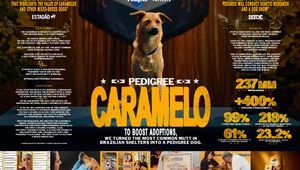
Behind Volkswagen’s Deepfake Daughter Duet

In celebration of Volkswagen’s 70th anniversary in Brazil, this campaign by AlmapBBDO used artificial intelligence to reunite Elis Regina, one of the greatest Brazilian singers of all time, with her daughter Maria Rita, a modern-day icon with eight Grammys to her name.
Since Elis passed 41 years ago, this reunion meant a lot - not just to Maria Rita and her other family members, but also to the Brazilian public who helped the project reach over 50 million organic views in the days following its release. Topping the trending charts at Google, Twitter (X) and YouTube, the two-minute film took the nation by storm and solidified the brand’s connection with Brazilians.
Speaking to LBB’s Ben Conway, AlmapBBDO’s executive creative director, Rodrigo Almeida discusses how the mother-daughter duet was recorded, how the team used deep fake and AI technologies to create the Elis Regina we see in the film, and why Volkswagen’s Brazilian history is inextricably linked to AlmapBBDO.
LBB> How did this project come about? What is your working relationship like with VW?
Rodrigo> We started thinking about VW’s 70th anniversary in Brazil last September. We couldn’t let the date pass us by and we wanted to do something emblematic. After all, every Brazilian has a story with a Volkswagen, be it a Fusca, a Brasília, a Kombi, or a Gol. That emotional connection and nostalgia was something that only VW could harness. At the same time, the brand was in a different phase, bringing electric and hybrid models into the market and investing heavily for the years to come. So, we were at a point where we had to honour our poetic past while also looking toward the future: a generational coming-together.
We couldn’t be more honoured to be a part of this project. After all, of the brand’s 70-year history in Brazil, 67 of those have been spent with Almap. It’s the longest agency-client relationship in the history of Brazilian advertising. So VW’s history, in a sense, is our history as well.
LBB> Where did the idea come from to reunite two generations of people to celebrate the brand’s 70th anniversary? And why did you choose Elis Regina and her daughter?
Rodrigo> In the thick of the creative process of blending the brand’s 70th anniversary with the arrival of electric cars in Brazil, reviving the poetry of the past and looking toward a bright new future, we decided to create a generation-spanning reunion that never came to pass: a duet sung by Elis Regina, who’s seen as one of the best Brazilian singers of all time, and her daughter Maria Rita, a fellow singer and eight-time Latin Grammy winner.
Elis died when Maria Rita was just four years old, leaving the country to wonder what a mother-daughter duet between these two icons might have looked like. We believed that giving people the chance to witness the scene would touch their hearts and strengthen their emotional connection to the brand in the process. That’s how we arrived at the first version of the script, an enchanting scene of the two women singing a classic Brazilian hit that speaks to change and the relationships between generations.
LBB> How did Maria Rita react to the idea? Were there any apprehensions about starring - and duetting - with an AI version of Elis?
Rodrigo> When it came to this special project, we completely upended our normal processes. Even before presenting the idea to Volkswagen, we spoke to the people with the biggest stake in protecting Elis Regina's image: Maria Rita and her brothers, singer Pedro Mariano and music producer João Marcello Bôscoli. We had to make sure they approved of the idea and thought it made sense. All three of Elis's children approved, and were immediately moved by the prospect, especially because it meant a dream come true for Maria Rita to be able to sing alongside her mother. She needed no convincing. She was on board from day one.
LBB> What AI technologies brought Elis Regina to life for this film? Which companies did you work with to create the AI Elis?
Rodrigo> The production company for the film was Boiler Films, and for the AI, we partnered with Flow VFX. Production on the film involved extensive AI training – specifically, autoencoders working with StyleGAN 3. Unlike traditional deep fake technology, which is available on websites and apps, this combination allows for a perfect blend of real and generated facial imagery. An initial data set is created using images and videos of the face to be reconstructed, capturing it from all different angles, in different lighting settings and expressions, to train the autoencoders. These are divided into two categories - an encoder and a GAN decoder - to map and reconstruct a given facial identity. This process, which is known as performance capture, allows AI models to track and map expressions and movements.
During post-production, models refine the scenes with the transplanted faces in a series of renders and stages. And even after that, there comes a phase of painstaking manual adjustments at the frame level to help the AI by correcting colours, adjusting lighting and removing artefacts to ensure visual realism. What guarantees the quality of the AI is the combination of the algorithms and the manual work of the artists in producing the data set and selecting scenes to arrive at the final composition.

LBB> What were the biggest challenges in creating the AI Elis?
Rodrigo> The greatest challenge was finding high-quality footage and images of Elis Regina. We're talking about someone who hasn't been among us for over four decades. The little material we were able to find had to be remastered. And given the lack of high-quality period material, we had to blend very different images of Elis from different time periods; the Elis of 1974 looked very different from the Elis of 1981.
When the computer analysed all of them together, it wound up creating an ‘average’ face – which might make sense for the algorithm, but failed to resemble the artist we all know and love. So it was an exhaustive, painstaking process of selecting, rendering, and applying the correct images and working frame by frame to arrive at the final result. People are taken aback at the point in the film where she shows up driving the Kombi, and they all go: “It's Elis!"
LBB> How was the process of recording the duet? Who picked the song, and why?
Rodrigo> The Elis Regina you hear singing in the film is her original voice, with no AI interference whatsoever. Using Elis’ original recording, Maria Rita recorded her part in the duet, riffing off her mother’s voice to create her own interpretation. We chose ‘Como Nossos Pais’ by Belchior, for more than one reason: it’s one of Elis’ iconic hits, one of the biggest classics in the history of Brazilian popular music and the poetry of the lyrics spoke to our message precisely: the song is about change, the relationship between generations, and it closes out with the message that “the new always comes.”
LBB> Were you on set at all? If so, tell us a bit about the production process!
Rodrigo> Of course! We wouldn’t miss the shoot for the world. We knew it’d be historic and unforgettable. For the main scene (the duet), we used three special vehicles besides the cars that appear in the film: one camera car and two tow trucks. One of them was carrying the ID. Buzz with Maria Rita in it. The other was carrying the Kombi, with an actress standing in for Elis Regina. That part of the film was shot at a flying club, since it was a location with wide runways. The background was refined in post to give it a magical, playful air. The rest of the film was shot on three separate days at different locations – beaches, highways, and mountains – in order to tell even more stories about Brazilians and their Volkswagens.
LBB> How did you react to the final piece? Seeing Maria Rita with her mother and singing together must have been an emotional moment!
Rodrigo> Everyone who was a part of this project was emotional about it from start to finish. There are videos of the moment we first played the final piece, but we haven’t shared them with anyone yet. Just imagine 20 people in a room, all in tears, getting chills, completely moved. And the most amazing part is that we saw thousands of people having the same reaction. The film was launched at a Volkswagen event for 5,000 partners who didn’t know that the project was underway. It was a collective outpouring in a huge gym in the city of São Paulo. People were sobbing, hugging one another, showing us how they’d gotten goosebumps watching it.
LBB> What was the hardest challenge you faced on this campaign, and how did you overcome it?
Rodrigo> The greatest challenge of all was arriving at a representation of Elis that could do justice to one of the biggest stars in Brazilian history. Plus, time wasn’t exactly on our side. Our deadline was written in stone: the day of Volkswagen’s 70th anniversary, a celebration for 5,000 guests, including the global board. And for a number of logistical reasons, we only wrapped up shooting about 20 days before the event. That meant under three weeks of intense post-production and adjustments to the deep fake and the music in order to get the project ready on time. Maria Rita, for example, only saw the final product two hours before the film was released.
LBB> After release, this campaign got over 50 million organic views and was trending everywhere - why do you think it’s been so successful? And what does it mean to you to see how well-received the film has been?
Rodrigo> Well, we were all expecting a hit. We were sure of that because all the feedback we got gave us that impression. But despite that confidence, we couldn’t have imagined a hit this overwhelming in our wildest dreams. The film was shown at a VW event at 11 PM on a Monday, and then posted by Maria Rita. By the time we woke up on Tuesday, all sorts of people, from communications and marketing professionals to our own families, were sending us our own video on WhatsApp. By 7 AM, Brazil’s own first lady had posted the video on Twitter, saying it had moved her to tears.
I think there are plenty of elements that made people take a liking to the film. A mother-daughter duet that Brazilians had always imagined is certainly the strongest of them. But the song, which is one of the biggest classics in Brazilian popular music, also played a huge role. And then there’s the nostalgia – both the scenes we chose and the cars that appear in the film spark a deep, powerful feeling in people.
One of the insights that led to the film was: ‘every Brazilian has at least one story with a Volkswagen’. We’re talking about a brand that can truly say that it’s a part of Brazilians’ lives and Brazilian culture. And we believe that from here on out, they’ll have one more memory. A few years from now, there will be people in Brazil asking one another, “Remember that Volks commercial with Elis?”















